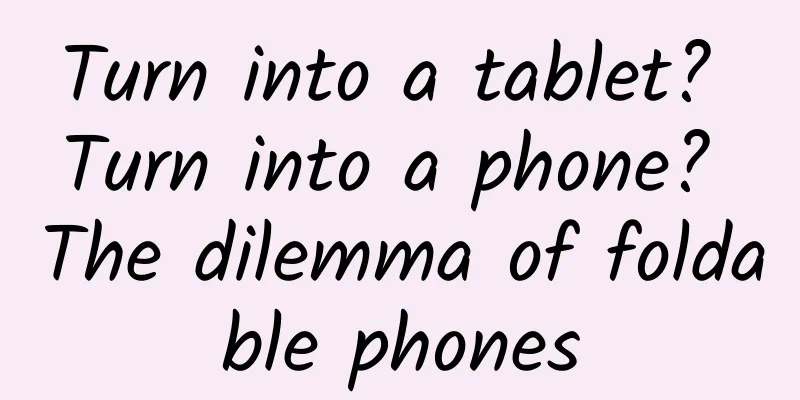Turn into a tablet? Turn into a phone? The dilemma of foldable phones

|
As the saying goes, "Beautiful appearances are all alike, but interesting souls are rare to find." When you unfold the latest foldable phone among a crowd of "same-looking" people, you become the "one in a million". In recent years, the design of smartphones has become more and more homogeneous, and the unchanging candy-bar phones have caused visual fatigue for consumers. The timely appearance of foldable screen phones has quickly detonated the market, and some people even predicted that foldable screen phones are the future form of mobile phones. But until 2020, foldable screens are still a lot of hype but little action. Even manufacturers have not yet reached a conclusion on whether foldable screens should be used on tablets or mobile phones. Folding screen - is it a phone or a tablet? Why make foldable phones? A big part of the reason is that people want to enjoy a larger screen without losing portability. In the early days, Steve Jobs said that 3.5 inches was the perfect golden size, but nowadays, a mobile phone cannot be held in one hand. If we can fold the screen, wouldn’t that solve the problem of the screen being too large? Judging from the existing products, each major manufacturer has its own unique folding screen design, but it can be roughly divided into three forms:
These three designs also represent the two schools of thought of current foldable screen mobile phones:
Although Samsung and Huawei are leading the foldable phone market, it was not any of them that launched the world's first foldable phone. In 2018, a Chinese brand took the lead in launching a foldable smartphone, and that company is Royole. It's a pity that the Flexpai, which was sold as a "smartphone + tablet", quickly fell into obscurity after a brief period of surprise - with a rough and simple design and poor user experience, the foldable screen phone exposed its shortcomings from the very beginning. However, Royole’s real purpose is to promote its own flexible screen products, so mobile phone quality control is not an issue they care about. But this phone opened up new ideas for other mobile phone manufacturers - is it feasible to turn a mobile phone into a tablet? At the beginning of the new year of 2019, Samsung launched the Galaxy Fold in San Francisco. Four days later, Huawei launched the Mate X at MWC. Both products use flexible screens that can be folded and flipped, and when opened, they become a mini tablet. Integrating the functions of a tablet computer into a mobile phone seems to continue the evolution of mobile phones: from simple call functions, it gradually integrated radios, MP3s, cameras, and even remote controls and bus cards. As technological difficulties continue to be overcome, we can put more and more micro components into mobile phones and give them more functions. Folding screen phones can give smartphones a tablet-like screen look and feel. Is turning a mobile phone into a tablet really what we need? The answer is naturally no. At least from the current level of technology, a folding-screen mobile phone with a tablet as its selling point is not a qualified product. Huawei Mate X is 8 inches when unfolded and 6.6 inches when folded; Samsung Galaxy Fold is 7.3 inches when unfolded, but due to the inner folding, the screen is only a small 4.7 inches when folded, while the current mainstream smartphones are already around 6.5 inches. Choosing an 8-inch iPad mini is much more affordable than choosing a folding screen phone. This concept of "folding a tablet in half to use as a phone" actually reduces the user experience when using them as mobile phones. Battery life and weight are also two issues that cannot be ignored for foldable screen phones. As a "tablet computer", ordinary mobile phone batteries naturally cannot meet the battery life requirements. If the battery capacity is increased according to the tablet computer standard, the weight of the phone will be increased invisibly. Huawei Mate X weighs 300g, and Samsung Galaxy Fold weighs 276g. For reference, an iPad mini also weighs 300g, and most of the current flagship phones that are used a lot are just over 200g. In this comparison, when the shell material cannot be upgraded, foldable screen mobile phones have become a complete burden for users. Finally, the Android tablet system is not yet fully adapted to foldable screen phones. Many software cannot recognize tablet mode, but directly stretch the software to a 1:1 state, or even leave black borders on both sides of the phone. It is not the 3:2 commonly seen in tablets, or the 16:9 that is more suitable for audio and video. This makes users feel very uncomfortable when watching. So from now on, it is still difficult for tablet-style folding-screen mobile phones to win the hearts of users. Folding screen mobile phone, the essence is still a mobile phone Back to the original question: Is the foldable screen mobile phone the future form of mobile phones? Before new ideas emerge, more mobile phone manufacturers will join the research and development of foldable screen mobile phones in the future. It is not foldable screen mobile phones that lead the trend, but foldable screen mobile phones that lead the manufacturers. In 2012, major manufacturers launched ultrabooks in order to save the PC industry. However, the ultrabooks did not save the PC from decline. Users did not buy into the new form factor that manufacturers had forced them to promote. After buying the ultrabooks, they actually still used them as traditional notebooks, and basically did not use the so-called new form factor and interaction. Everything was back to square one. The same goes for today's foldable screen mobile phones. No matter how they are changed, they should essentially be mobile phones, not tablets. As representative models of flip-folding screens, Samsung Galaxy Z Flip and MOTO Razr have given folding screen phones a new idea: when opened, it is a straight-screen phone, and when folded, it is a flip phone. Figure | The once popular ultrabook For the popularization of foldable screen mobile phones, manufacturers should not directly launch new forms to replace them, but follow a long-term approach and slowly transition from existing technologies to new technologies, guiding more users to know about foldable screen technology so that they can adapt to and accept it. Galaxy Fold uses its folding screen to tell us that a mobile phone can be transformed into a personal tablet computer through the screen, so it not only has the attributes of a mobile phone, but also has the attributes of a portable office tool. The Galaxy Z Flip and MOTO Razr are still essentially mobile phones, which is exactly the foldable screen mobile phones that current users really need. end From the manufacturer's perspective: foldable screen mobile phones are more like a means for mobile phone manufacturers to demonstrate the latest technologies in the face of innovation anxiety. Whether it is Royole promoting its own screen technology or Huawei and Samsung launching products first, they need foldable screen products to establish their own status and brand. Once the industry enters the mature stage, they can quickly seize the market. If you want to change the current mobile phone market, you must have some alternatives. Whether the emergence of foldable screen mobile phones can change the current mobile phone market depends on the final audience's acceptance of this product. If people are willing to change to a folding-screen phone, not because of its advanced concept or novel design, but because they accept this type of phone and feel out of date if they don't change, then the generation change is successful; if consumers buy it just out of curiosity, then straight-screen phones will still be the mainstream in the future. As for the advantages and disadvantages of tablet mode and mobile phone mode, the market and technology are always improving, and mobile phone manufacturers will also try their best to improve product quality so that their products can better serve consumers. As for the two types of products, the folding type and the clamshell type, which one will be more popular with consumers depends on the performance of each brand in the future. |
<<: 5 predictions for IoT and mobile app integration
>>: I was wrong. It turns out that iPad can really install Windows and MacOS systems
Recommend
Why is Mount Everest still growing taller?
Mountains are an important geomorphic unit on Ear...
Thirty years of mobile phones: from big brothers to smartphones, most mobile phone brands have disappeared
Mobile phones have been used in China for 30 year...
Bird watching, you really don’t need to buy a camera! Prenatal bird watching tutorial is here
Bird watching has become increasingly popular rec...
Watch Joy of Life online for free, watch Joy of Life online for free full version and high definition!
When Fan Xian was fifteen years old, his father F...
There is a poison called "seven aunts and eight aunts", let's see how major brands can help you detoxify
As the year draws to a close, in addition to the ...
Summary of NetEase’s screen-sweeping rules: How to master the H5 fission methodology?
It has become a rule in 2018 that any product pro...
Tips for Weibo promotion and traffic generation
Weibo can be said to be a big brother-level platf...
What are the functions of the insurance mini program? How much does it cost to develop a WeChat insurance mini program?
Not long ago, a colleague of mine bought another i...
Coastal Archaeology: Searching for Sunken Civilizations
Part of human history lies in the seabed corals, ...
Attention! WeChat often pops up this type of ads, which means you are being "monitored". Please close it as soon as possible
The ads placed by WeChat have made many users pon...
How can APP achieve fission-like dissemination and capture the user's psychology?
The most important thing about fission-style comm...
How to deploy DOU+ most effectively? Chen Jiangxiong: Douyin DOU+ high-end paid courses Baidu Netdisk (worth 9980)
If you chat with a stranger and say, "Brothe...
The underlying logic behind Tik Tok’s full-case marketing!
In recent years, new brands have risen rapidly, n...
Chrysler CES releases electric concept car with elevator door opening and closing
Fiat Chrysler will release its first pure electri...
2017 e-commerce marketing report! What are the new ways to play?
The transaction volume on Double 11 this year hit...









